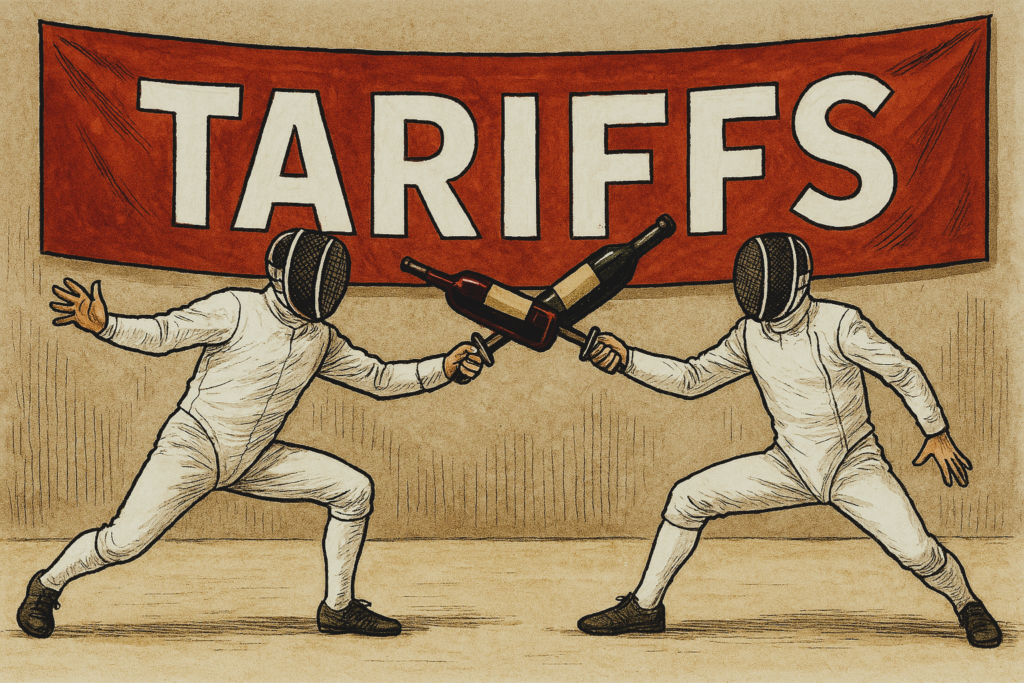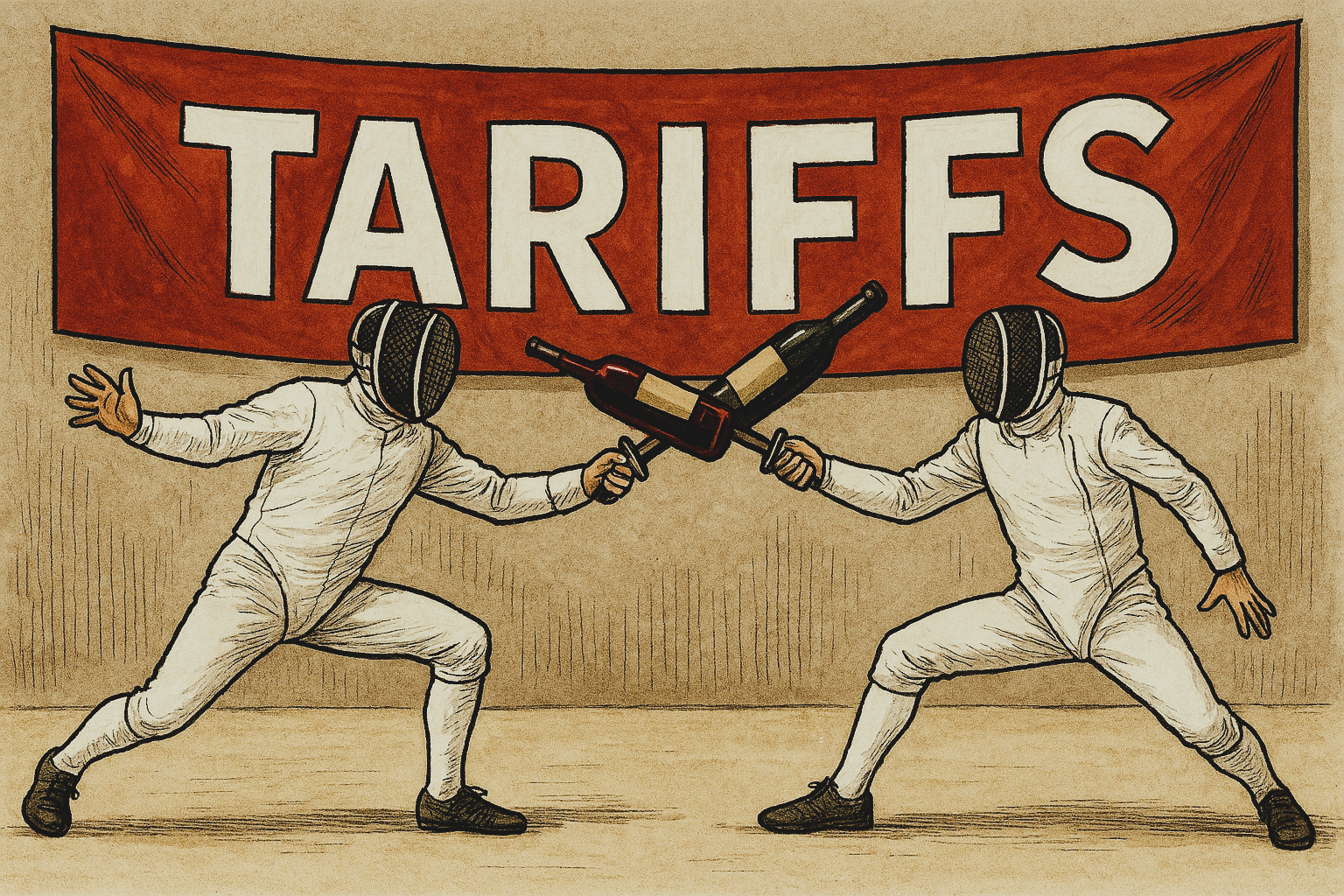A staple of European exports, the wine industry faces unprecedented challenges ahead…

(Tariff fencing match, generated by ChatGPT, 13/03/25)
Late March 2025, I managed — through questionable means — to snatch a few free tickets to attend the Vinitaly wine fair [1] one of the largest in the world, it is held in Verona, Italy. My intentions were simple: catch up with a few local friends and, quite frankly, perpetuate this millenia-old tradition of drinking fermented grape juice. That was, until April 2nd.
That Wednesday, just four days before Vinitaly’s opening, Donald Trump, the President of the United States held a press conference declaring an incoming ‘Liberation Day’ — a global wave of tariffs to be applied to most nations (including territories populated solely by penguins) [2]. Europe, he announced, would be hit from April 9th with a 20% tariff on all exports to the U.S [2].
(Post-edit note: On April 9th, just 12 hours after the tariff rollout began, Trump announced a 90-day suspension for most countries — with the notable exception of China [27]).
The wine sector has been dealing with a worrying convergence of headwinds: post-COVID inflation, an economic slowdown in China (a major luxury goods importer), climate change, and shifting consumption patterns. With these new tariffs, it’s unclear how much more the industry can absorb without sustaining deeper wounds [3].
In this environment, what does the over $300 billion wine industry stand to lose? How can it navigate such turbulent times? And how will the broader luxury sector fare in these choppy waters [4]?
After the COVID-19 pandemic, the wine industry saw a solid rebound, spurred by the reopening of borders, the return of travel, and the quick adoption of digital sales channels [4]. Whilst the broader luxury sector has shown resilience even in the face of inflation, wine buyers — even high net worth consumers — tend to be more price sensitive, which explains the 2,9% slump in sales in 2023 compared to the previous year [5].
Even the fine wine market has struggled, with most fine wine indexes charts concaving[6], due to political uncertainty, a 25% drop in Chinese consumption, and a growing shift in demand toward organic, unfiltered products as well as small producers [7]. If you’re looking to snap up a 2000 Right Bank Bordeaux, now might be the time as prices may have reached a dip [8].
At first glance, it might be difficult to assess the direct impact of tariffs on the industry, as the USA is the first wine importer. But if history is any guide, this isn’t Trump’s first trade war crusade.
In 2019, after a dispute over state subsidies by the European Union to its aeronautic industry, the Trump administration imposed a 25% tariff on exports of British whiskies, French non-sparkling wines and cheeses, and a host of other European agricultural goods [9]. Those tariffs lasted just 16 months, but were enough to decrease sales volume in the USA by 15% in 2020 [10].
(For transparency sake: in 2018, the WTO’s Appellate Body found the EU had not fully complied with earlier rulings on Airbus subsidies, granting the U.S. legal grounds for countermeasures. A year later, a similar case was decided against the U.S. and Boeing, escalating retaliatory tariffs from both sides. A truce was only brokered in 2021, under President Biden — a reminder that tariffs rarely benefit anyone in the long run, and that Trump’s attacks are not always unfounded) [12].
The Fédération Des Exportateurs de Vin et Spiritueux de France (FEVS) estimates the “Airbus tax” to have shaved $400m off industry revenue [11].
Today the EU is mustering a response — with both carrots and sticks. Although the commission has shown willingness to negotiate a “zero to zero” tariff strategy on a wide range of sectors, it also has proposed targeted reciprocal ones on American goods as a clear signal to the White House. Those include products like bourbons, clothing, farm products, boats [13].
But shortly after in the negotiation, Trump threatened to impose a 200% tariff on all EU alcohol if American bourbon was targeted [14]. Major member state wine producers quickly managed to, for the time being, remove bourbons from the list. The FEVS estimates that if the 20% tariffs hit the EU alcohol exports, EU exports will decrease by as much as $1.6 billion, with France expected to bear 50% of this loss on its own [15].
(Trump’s Truth social post,13/03/25)
Industries across Europe vary widely from one country to another. While wine producers and luxury brands from France, Italy and Spain are trying to bargain for their own needs, the Germans are trying to protect their own industries: Industrial & pharmaceutical goods and cars[13]. A joint response from the Union is needed, so as not to relive COVID’s protective gear battle between EU countries [16].
Trump’s tariff war, however misguided it is, might be the catalyst for major long-lasting changes in the industry [17]. Worldwide consumption was down nearly 7% between 2019 and 2023 while production plummeted by a historic 10% between 2022 and 2023 [4][18]. This sudden fall in production is attributed to difficult climatic events, with northern producers experiencing rainy spring, flood damage, at the same time as southern producers fought against severe droughts [3].
With the more health conscious Gen Z, wine makers are also trying to depart from their high ABV (Alcohol By Volume) red wines and focus more on white, sparklings as well as 0% wines [19]. The sober conscious movement is shifting consumption behaviours towards healthier alternatives, not only in wines but in every other beverage, in an alcohol-free market that is expecting a far greater yearly growth than the traditional alcohol beverages (the former is expecting growth averaging 6-7% whilst the latter only 3% growth until the end of the decade) [20].
To add to the already gloomy picture, some are already predicting that alcoholic beverages might be about to face its “big tobacco moment” — the realization that any consumption is at the expense of one’s health [21]. “A glass of red wine per day is good for your health” is an adage from a different millennium [22].
After many health warnings conducted on behalf of authorities, countries are moving forward with stricter labeling. From 2026 onwards, Ireland will be the first European country to introduce clear health warnings on alcohol products [23].This could pave the way for tobacco-like restrictions, such as on TV advertisements, packaging, though in an industry that employs directly and indirectly nearly a million workers globally, the changes will be both slow and painful for some [4].
Zooming out, the fate of the wine industry epitomizes broader trends in luxury. The stock prices of major houses have taken a notable hit. On France’s CAC 40 index, LVMH and Kering rank among the top decliners, down 19% and 34% respectively [24]. But unlike the wine industry, luxury conglomerates have already leveraged price hikes as a countermeasure after COVID, sometimes going as far as doubling the price tags to juice up margins, at the expense of a less affluent customer segment unable to bear the price hikes [25].
In the short term, reduced exports to the US means redirecting part of those products to new markets. A surplus in goods and lower prices is expected to be the first effect of such rerouting [26]. In the medium to long term, a fractured global economy, escalating trade wars, and a possible U.S. recession could trigger wider economic consequences—from shrinking output to job losses. However, an alternative that seems increasingly plausible is a strengthened EU that remodels — and is at the center of — a new trading framework. I raise my glass to the latter.
Walking through Vinitaly’s hall maze, losing myself amongst the sellers’ aisle, all competing for my attention, bumping into other attendees coming in thousands from all around the world, there is a sense that this industry is not going down any time soon. My friends and I jumped from one booth to the next, collecting nectar like bees, and suddenly one booth stood out in the Tuscany hall. People were lining up in front of it, waiting to taste what I could imagine to be another lovely wine from the region. But when getting close, I saw that they were showcasing only 0% red and white wines, as well as ciders.
I did not hesitate to line up to have a try, but as I turned around, I saw my acolytes from Verona, immobile, staring at me with a judgmental look of revulsion from afar, as if I was breaking a stack of spaghetti in half with my bare hands in front of their faces.
If the sex appeal of a cigarette on the side of the mouth has vanished since its Hollywood heyday in the 50s, surely the stigma of enjoying an alcohol-free drink in a wine heartland as Veneto or Burgundy will fade away someday, probably sooner than expected.
~
Sources:
[1]: Veronafiere. (n.d.). Map and halls. Vinitaly. Retrieved April 8, 2025, from https://www.vinitaly.com/en/map-and-halls/
[2]: The New York Times. (2025). Europe tariffs Trump response. Retrieved April 8, 2025, from https://www.nytimes.com/2025/04/07/world/europe/europe-tariffs-trump-response.html
[3]: OIV. (2024). State of the world vine and wine sector in 2023. Retrieved April 8, 2025, from https://www.oiv.int/sites/default/files/2024-04/OIV_STATE_OF_THE_WORLD_VINE_AND_WINE_SECTOR_IN_2023.pdf
[4]: Vergamini, R. (2021). Covid-19 and the wine industry: Short-term impacts and future threats. Bio-based and Applied Economics, 10(1), 51–71. https://doi.org/10.36253/bae-9017
[5]: Statista. (n.d.). Global wine. Retrieved April 8, 2025, from https://www.statista.com/topics/7802/global-wine/#topicOverview
[6]: Liv-ex. (n.d.). Indices. Retrieved April 8, 2025, from https://www.liv-ex.com/news-insights/indices/
[7]: Chau, A. (2024, December 19). 5 wine industry trends to watch in 2025. SevenFifty Daily. https://daily.sevenfifty.com/5-wine-industry-trends-to-watch-in-2025/
[8]: WineCap. (n.d.). Opportunities in uncertainty: The 2024 fine wine market and 2025 outlook. Retrieved April 8, 2025, from https://winecap.com/learn/report-opportunities-in-uncertainty-the-2024-fine-wine-market-and-2025-outlook
[9]: The New York Times. (2019). Airbus tariffs WTO. Retrieved April 8, 2025, from https://www.nytimes.com/2019/10/02/us/politics/airbus-tariffs-wto.html
[10]: The Guardian. (2019). US may impose $7.5bn of tariffs on EU over Airbus subsidies. Retrieved April 8, 2025, from https://www.theguardian.com/business/2019/oct/02/us-may-impose-75bn-of-tariffs-on-eu-over-airbus-subsidies
[11]: Fédération des Exportateurs de Vins & Spiritueux de France. (2021, February). Impact des droits de douane américains sur les exportations françaises de vins et spiritueux. https://www.fevs.com/wp-content/uploads/2021/02/cp1102.pdf
[12]: Decanter. (n.d.). French wine exports sink due to US tariffs, Covid-19. Retrieved April 8, 2025, from https://www.decanter.com/wine-news/french-wine-exports-sink-due-to-us-tariffs-covid-19-453387/#:~:text=A%2025,the%20UK%20in%20October%202019
[13]: Financial Times. (n.d.). Europe tariffs Trump response. Retrieved April 8, 2025, from https://www.ft.com/content/180063de-15a8-4077-8daf-a6a591e117ec
[14]: European Commission. (2021). Press corner. Retrieved April 8, 2025, from https://ec.europa.eu/commission/presscorner/detail/en/ip_21_3001
[15]: Reuters. (2025, April 2). French wine & spirits sales expected to fall 20% after U.S. tariff announcement. https://www.reuters.com/business/retail-consumer/french-wine-spirits-sales-expected-fall-20-after-us-tariff-announcement-2025-04-02/
[16]: European Commission. (n.d.). Coronavirus response: Flow of protective equipment in the internal market. Single Market Economy. https://single-market-economy.ec.europa.eu/single-market/internal-market-emergency-and-resilience-act/coronavirus-response-flow-protective-equipment-internal-market_en
[17]: Business Standard. (2025). Does Trump’s reciprocal import tariffs violate WTO rules? An explainer. Retrieved April 8, 2025, from https://www.business-standard.com/world-news/does-trump-s-reciprocal-import-tariffs-violate-wto-rules-an-explainer-125021500782_1.html
[18]: IBISWorld. (n.d.). Global wine manufacturing. Retrieved April 8, 2025, from https://www.ibisworld.com/global/industry/global-wine-man
[19]: Forbes. (2024). Heavy drinking young adults are cutting back, study suggests. Here’s how the alcohol industry is still cashing in. Retrieved April 8, 2025, from https://www.forbes.com/sites/ariannajohnson/2024/05/02/heavy-drinking-young-adults-are-cutting-back-study-suggests-heres-how-the-alcohol-industry-is-still-cashing-in/
[20]: Beverage Daily. (2025). Global low and no alcohol market data for 2025. Retrieved April 8, 2025, from https://www.beveragedaily.com/Article/2025/01/29/global-low-and-no-alcohol-market-data-for-2025/
[21]: Financial Times (2025). Booze faces its “big tobacco moment”. Retrieved from: https://www.ft.com/content/c43c3698-100e-42c5-b44c-a189685afd7e
[22]: Wine Enthusiast. (n.d.). Glass of wine a day. Retrieved April 8, 2025, from https://www.wineenthusiast.com/culture/glass-of-wine-a-day/
[23]: World Health Organization. (2023). What’s in the bottle? Ireland leads the way as the first country in the EU to introduce comprehensive health labelling of alcohol products. Retrieved April 8, 2025, from https://www.who.int/europe/news/item/26-05-2023-what-s-in-the-bottle–ireland-leads-the-way-as-the-first-country-in-the-eu-to-introduce-comprehensive-health-labelling-of-alcohol-products
[24]: Euronext. (n.d.). CAC 40®. ttps://live.euronext.com/en/product/indices/FR0003500008-XPAR
[25]: Fashion Network. (n.d.). Rising product prices adversely affecting luxury sector. Retrieved April 8, 2025, from https://ww.fashionnetwork.com/news/Rising-product-prices-adversely-affecting-luxury-sector,1679284.html
[26]: Euronews. (2025, March 13). What will be the impact of a US-EU trade war on the life of EU citizens. Retrieved April 8, 2025, from https://www.euronews.com/my-europe/2025/03/13/what-will-be-the-impact-of-a-us-eu-trade-war-on-the-life-of-eu-citizens
[27]: Financial Times. (2025, April 10). Trump’s tariff pause: What does it mean for global trade? Financial Times. https://www.ft.com/content/60fb095e-0961-4117-ae28-8bf6fe16240a
[Cover Image] Tariff fencing match, generated by ChatGPT, 13/03/25.

Leave a Reply